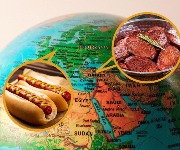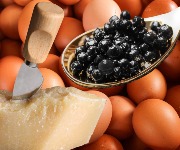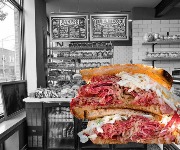The loveFOOD guide to... butter

Butter: it's not just for spreading on toast. Here’s our guide to that most wonderful of ingredients.
Unsalted butter
Butter is made by separating the cream from fresh, full fat milk. This will have come straight from the cow (though it may be pasteurised first), and will have a much higher natural fat content than even blue top milk. The cream is then churned until the fat molecules begin to form solids. The butter is then removed, washed and shaped while the remaining liquid (called 'buttermilk', used in scones and soda bread) is strained off. Unsalted butter is recommended in most forms of cooking (particularly baking) as it lets you control the salt levels.
Bread and butter pudding recipe
Salted butter
Salt is added to butter for two main reasons: one is flavour, and the other is to preserve it - salted butter lasts longer than unsalted.
Lamb tagine with apricots and salted almonds recipe
Unpasteurised or ‘raw’ butter
Like milk, nearly all butter is pasteurised. However, there are some - mainly French - producers that offer an unpasteurised version. Which is ironic as it was a Frenchman, Louise Pasteur, who invented the process in the first place. Pasteurisation strips out potentially harmful bacteria, but also plenty of harmless things too. There are those that think that unpasteurised cheese, butter and milk taste more complex and richer than treated milk.
Spreadable butter
A number of manufactures now produce butter blended with vegetable oil. This means it’s spreadable straight from the fridge.
Pan-roasted lamb leg chops with herb butter recipe
Goats' butter
You can make butter from any mammalian milk (camel butter and cheese seem to present some problems thought). Though butter made with cow’s milk is by far and away the most popular, butter made with goat’s milk is available in many large supermarkets. This product is no doubt aimed at shoppers who are allergic to products made with cow's milk. Interestingly, many goats' butter producers add a small amount of carotene (the same substance which makes carrots orange) to make their butter look more yellow, as this is what people expect. Without it, it would be much more white.
Twice-baked goats' cheese soufflés recipe
Margarine
Invented in 1869, margarine is made from vegetable oils emulsified with water. It was supposed to be a cheap alternative to butter, but in the past few decades has been marketed as healthier than butter. However, that claim is now being called into question, and interestingly sales of margarine are falling. It’s actually a dull grey colour when first made - a yellow colouring has to be added. Because it’s dairy-free, it’s often the spread of choice for people with an intolerance.
Gluten-free baked Apple Charlotte recipe
More butter articles
Home-made crumpets with burnt honey butter recipe
Pistachio and almond nut butter recipe
Basic techniques: How to cream butter and sugar
Heston Blumenthal's rich chilli con carne with spiced butter recipe
Most Recent
Comments
Be the first to comment
Do you want to comment on this article? You need to be signed in for this feature








